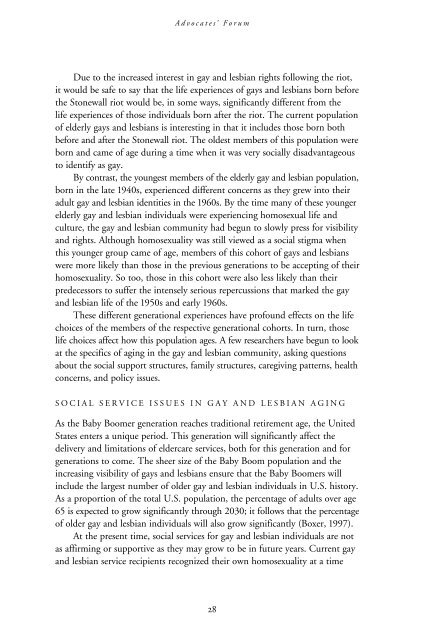2006 - School of Social Service Administration - University of Chicago
2006 - School of Social Service Administration - University of Chicago
2006 - School of Social Service Administration - University of Chicago
You also want an ePaper? Increase the reach of your titles
YUMPU automatically turns print PDFs into web optimized ePapers that Google loves.
Advocates’ Forum<br />
Due to the increased interest in gay and lesbian rights following the riot,<br />
it would be safe to say that the life experiences <strong>of</strong> gays and lesbians born before<br />
the Stonewall riot would be, in some ways, significantly different from the<br />
life experiences <strong>of</strong> those individuals born after the riot. The current population<br />
<strong>of</strong> elderly gays and lesbians is interesting in that it includes those born both<br />
before and after the Stonewall riot. The oldest members <strong>of</strong> this population were<br />
born and came <strong>of</strong> age during a time when it was very socially disadvantageous<br />
to identify as gay.<br />
By contrast, the youngest members <strong>of</strong> the elderly gay and lesbian population,<br />
born in the late 1940s, experienced different concerns as they grew into their<br />
adult gay and lesbian identities in the 1960s. By the time many <strong>of</strong> these younger<br />
elderly gay and lesbian individuals were experiencing homosexual life and<br />
culture, the gay and lesbian community had begun to slowly press for visibility<br />
and rights. Although homosexuality was still viewed as a social stigma when<br />
this younger group came <strong>of</strong> age, members <strong>of</strong> this cohort <strong>of</strong> gays and lesbians<br />
were more likely than those in the previous generations to be accepting <strong>of</strong> their<br />
homosexuality. So too, those in this cohort were also less likely than their<br />
predecessors to suffer the intensely serious repercussions that marked the gay<br />
and lesbian life <strong>of</strong> the 1950s and early 1960s.<br />
These different generational experiences have pr<strong>of</strong>ound effects on the life<br />
choices <strong>of</strong> the members <strong>of</strong> the respective generational cohorts. In turn, those<br />
life choices affect how this population ages. A few researchers have begun to look<br />
at the specifics <strong>of</strong> aging in the gay and lesbian community, asking questions<br />
about the social support structures, family structures, caregiving patterns, health<br />
concerns, and policy issues.<br />
SOCIAL SERVICE ISSUES IN GAY AND LESBIAN AGING<br />
As the Baby Boomer generation reaches traditional retirement age, the United<br />
States enters a unique period. This generation will significantly affect the<br />
delivery and limitations <strong>of</strong> eldercare services, both for this generation and for<br />
generations to come. The sheer size <strong>of</strong> the Baby Boom population and the<br />
increasing visibility <strong>of</strong> gays and lesbians ensure that the Baby Boomers will<br />
include the largest number <strong>of</strong> older gay and lesbian individuals in U.S. history.<br />
As a proportion <strong>of</strong> the total U.S. population, the percentage <strong>of</strong> adults over age<br />
65 is expected to grow significantly through 2030; it follows that the percentage<br />
<strong>of</strong> older gay and lesbian individuals will also grow significantly (Boxer, 1997).<br />
At the present time, social services for gay and lesbian individuals are not<br />
as affirming or supportive as they may grow to be in future years. Current gay<br />
and lesbian service recipients recognized their own homosexuality at a time<br />
28
















